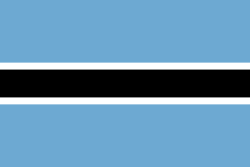| Part of a series on the |
| Culture of Botswana |
|---|
 |
| People |
| Languages |
| Cuisine |
| Religion |
| Art |
| Literature |
| Music |
| Sport |
The people of the country called Botswana are all referred to as Batswana(pl)/ Motswana(s) in reference to the country name or the land they all hail from , that is regardless of ethnicity, language, skin colour or heritage.
Contents
The population of Botswana can be best divided into a number of ethnicities with the ethnic Tswana being the largest followed by other ethnicities who speak Setswana as a secondary language. The ethnic Tswana populace are concentrated mostly in the southern, South-eastern as well as Central parts of the country and are split up among eight tribes: Bangwato, Bakwena, Bangwaketse, Bakgatla, Barolong, Batlokwa, Balete and Batawana.
The following ethnicity would be the ethnic Kalanga people populations who are found in the central, northern and north-eastern parts of the country. The Kalanga ethnicity is shared by a number of tribes namely: Lilima / Bawumbe, Talaote tribe, Nambya people & Banoka. These various groups of people all speak different dialects of the Kalanga language.
The third ethnicity is the San(Khoi-San) people consisting of numerous sub-groups. The people are most dominantly found in the formerly Kgalagadi District as well as Ghanzi districts. Other populations can be found in other parts of the country although they normally speak the languages of their closest neighbour tribes. The story of the Basarwa is a sad one as they are a people who have for long been nomadic as well as hunters and gatherers and it is for this reason a lot of them have not been able to hang onto their culture and normally end up being assimilated into the Bantu people they normally settle next to. Over the years their populations have seen a great decline in all the areas and countries they are found in and they continue to dwindle. It is for this reason the governments of the countries are trying to conserve what is left of their cultures & traditions.
Other tribes would be the Batswapong and Babirwa people who despite sharing linguistic similarities are different and unique in their cultures as well as having different histories. The two are found in the Central Districts of Botswana alongside Bangwato and Bakalanga people.
Botswana as a country also has the native Bakgalagadi population who are also found in the Kgalagadi & Ghanzi districts. Bakgalagadi are made up of a number of tribes like ;Bashaga,Barolong,Bangologa,Babolaangwe,etc and they speak the Shekgalahari language which is believed to have been formed through the interactions of the Early ethnic Tswana groups with different San(Basarwa) tribes.
The country does also have the Herero people people (incl. Ovambanderu), the Basubiya, Mbukushu as well as Bayei and all of them being situated in the North Western parts of the country alongside the ethnic Batawana and Bananzwa people.
Botswana also has small non-black populations across the country. The most noticeable of these people include those of British ancestry, Afrikaans-speaking people, and Asian populations. Most of the people from these groups are highly urbanised and therefore typically live in cities, towns or urban villages.

